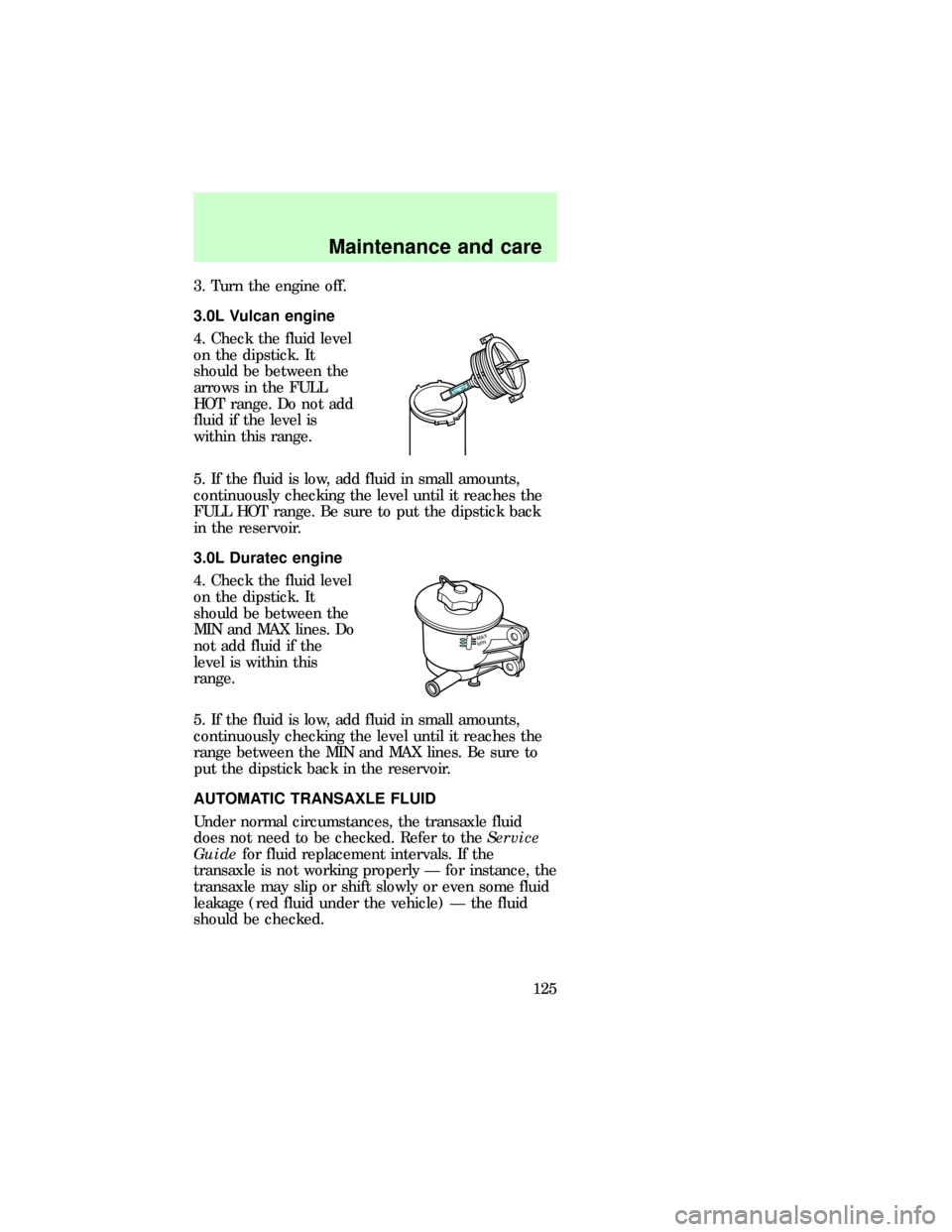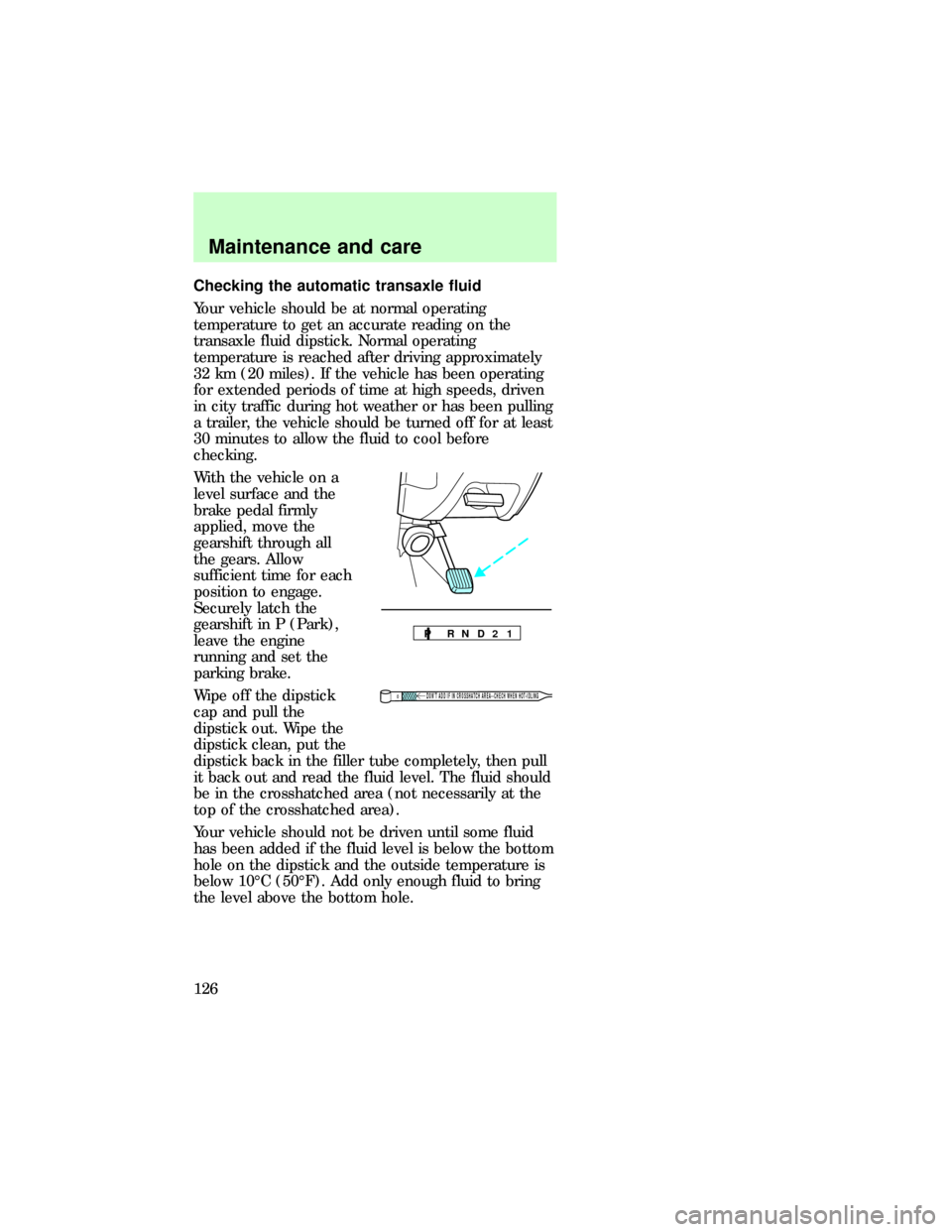engine Mercury Sable 1997 s Service Manual
[x] Cancel search | Manufacturer: MERCURY, Model Year: 1997, Model line: Sable, Model: Mercury Sable 1997Pages: 167, PDF Size: 1.59 MB
Page 124 of 167

Coolant refill capacity
To find out how much fluid your vehicle's cooling
system can hold, refer toRefill capacitiesin the
Capacities and specificationschapter.
Have your dealer check the engine cooling system
for leaks if you have to add more than a liter (quart)
of engine coolant per month.
Severe winter climate
If you drive in extremely cold climates [less than
±36ÉC (±34ÉF)], it may be necessary to increase the
coolant concentration above 50%. Refer to the chart
on the coolant container to ensure the coolant
concentration in your vehicle is such that the
coolant will not freeze at the temperature level in
which you drive during winter months. Never
increase the engine coolant concentration above
60%. Leave a 50/50 mixture of engine coolant and
water in your vehicle year-round in non-extreme
climates.
CHECKING AND ADDING POWER STEERING
FLUID
Check the power
steering fluid at least
twice a year. If adding
fluid is necessary, use
only MercontAT F
power steering fluid.
1. Start the engine and let it run until it reaches
normal operating temperature (the engine coolant
gauge will be near the center of the NORMAL band).
2. While the engine idles, turn the steering wheel
left and right several times.
com_winter_climate.01
dno_power-steering-fluid
Maintenance and care
124
Page 125 of 167

3. Turn the engine off.
3.0L Vulcan engine
4. Check the fluid level
on the dipstick. It
should be between the
arrows in the FULL
HOT range. Do not add
fluid if the level is
within this range.
5. If the fluid is low, add fluid in small amounts,
continuously checking the level until it reaches the
FULL HOT range. Be sure to put the dipstick back
in the reservoir.
3.0L Duratec engine
4. Check the fluid level
on the dipstick. It
should be between the
MIN and MAX lines. Do
not add fluid if the
level is within this
range.
5. If the fluid is low, add fluid in small amounts,
continuously checking the level until it reaches the
range between the MIN and MAX lines. Be sure to
put the dipstick back in the reservoir.
AUTOMATIC TRANSAXLE FLUID
Under normal circumstances, the transaxle fluid
does not need to be checked. Refer to theService
Guidefor fluid replacement intervals. If the
transaxle is not working properly Ð for instance, the
transaxle may slip or shift slowly or even some fluid
leakage (red fluid under the vehicle) Ð the fluid
should be checked.
FULL HOT
MINMAX
dno_steers
sab_steer
dno_transaxle-fluids
dno_checking-trans
Maintenance and care
125
Page 126 of 167

Checking the automatic transaxle fluid
Your vehicle should be at normal operating
temperature to get an accurate reading on the
transaxle fluid dipstick. Normal operating
temperature is reached after driving approximately
32 km (20 miles). If the vehicle has been operating
for extended periods of time at high speeds, driven
in city traffic during hot weather or has been pulling
a trailer, the vehicle should be turned off for at least
30 minutes to allow the fluid to cool before
checking.
With the vehicle on a
level surface and the
brake pedal firmly
applied, move the
gearshift through all
the gears. Allow
sufficient time for each
position to engage.
Securely latch the
gearshift in P (Park),
leave the engine
running and set the
parking brake.
Wipe off the dipstick
cap and pull the
dipstick out. Wipe the
dipstick clean, put the
dipstick back in the filler tube completely, then pull
it back out and read the fluid level. The fluid should
be in the crosshatched area (not necessarily at the
top of the crosshatched area).
Your vehicle should not be driven until some fluid
has been added if the fluid level is below the bottom
hole on the dipstick and the outside temperature is
below 10ÉC (50ÉF). Add only enough fluid to bring
the level above the bottom hole.
P R N D 2 1
DON’T ADD IF IN CROSSHATCH AREA--CHECH WHEN HOT-IDLING
dno_adding-fluid
Maintenance and care
126
Page 128 of 167

Applying too much pressure on the ends
when lifting a battery could cause acid to
spill. Lift the battery with a carrier or with your
hands on the opposite corners.
Servicing your battery
The low-maintenance battery has removable vent
caps for checking electrolyte level and adding water.
Check electrolyte level every 24 months or 40,000
km (24,000 miles) in an average temperature of
32ÉC (90ÉF). Keep the electrolyte level in each cell
up to the level indicator. Do not overfill.
If the level gets low, refill the battery with distilled
water. If necessary, distilled water may be
substituted with tap water that is not hard or has a
high mineral or alkali content. If the battery needs
water quite often, have the charging system checked
for a possible malfunction.
Because your vehicle's engine is electronically
controlled by a computer, some control conditions
are maintained by power from the battery. When the
battery is disconnected or a new battery is installed,
the engine must relearn its idle conditions before
you vehicle will drive properly. To begin this process:
1. Put the gearshift in P (Park), turn off all
accessories and start the vehicle.
2. Let the engine idle for at least one minute.
3. The relearning process will automatically
complete as you drive the vehicle.
²If you do not allow the engine to relearn its idle,
the idle quality of your vehicle may be adversely
affected until the idle is eventually relearned.
²If the battery has been disconnected or a new
battery has been installed, the clock and the
preset radio stations must be reset once the
battery is reconnected.
Maintenance and care
128
Page 136 of 167

engine will perform adequately on other gasolines,
the performance of the emission control devices and
systems may be adversely affected. Repair of
damage caused by using a fuel that your vehicle was
not designed for may not be covered by your
warranty.
Octane recommendations
Your vehicle is
designed to use regular
gasoline with an
(R+M)/2 octane rating
of 87. We do not
recommend gasolines
labeled as ªregularº in
high altitude areas that
are sold with octane
ratings of 86 or even less.
Do not be concerned if your vehicle sometimes
knocks lightly. However, if it knocks heavily under
most driving conditions on the recommended octane
fuel, see your dealer or a qualified service technician
to prevent any engine damage.
Fuel quality
If you are experiencing starting, rough idle or
hesitation problems try a different brand of fuel. If
the condition persists, see your dealer or a qualified
service technician.
The American Automobile Manufacturers Association
(AAMA) issued a gasoline specification to provide
information on high quality fuels that optimize the
performance of your vehicle. We recommend the use
of gasolines that meet the AAMA specification if
they are available.
It should not be necessary to add any aftermarket
products to your fuel tank if you continue to use a
high-quality fuel.
87
com_octane_recommendations.01
com_fuel_quality.01
com_cleaner_air.01
Maintenance and care
136
Page 138 of 167

To make sure that the catalytic converter and the
other emission control parts continue to work
properly:
²Use only unleaded fuel.
²Avoid running out of fuel.
²Do not turn off the ignition while your vehicle is
moving, especially at high speeds.
²Have the services listed in yourService Guide
performed according to the specified schedule.
The Scheduled Maintenance Services listed in the
Service Guideare required because they are
considered essential to the life and performance of
your vehicle and to its emissions system.
Ford strongly recommends the use of genuine Ford
replacement parts. If other than Ford or Motorcraft
parts or Ford authorized parts are used for
maintenance replacements or for the service of
components affecting emission control, such
non-Ford parts should be equivalent to genuine Ford
Motor Company parts in performance and durability.
It is the owner's responsibility to determine the
equivalency of such parts. Please consult your
Warranty Information Booklet for complete warranty
information.
Do not park, idle, or drive your vehicle in
dry grass or other dry ground cover. The
emission system heats up the engine compartment
and exhaust system, which can start a fire.
Watch for fluid leaks, strange odors, smoke, loss of
oil pressure, the charging system warning light, the
service engine soon light or the temperature warning
light. These sometimes indicate that the emissions
system is not working properly.
Do not make any unauthorized changes to your
vehicle or engine. Changes that cause more
Maintenance and care
138
Page 139 of 167

unburned fuel to reach the exhaust system can
increase the temperature of the engine or exhaust
system.
By law, anyone who manufactures, repairs, services,
sells, leases, trades vehicles, or supervises a fleet of
vehicles is not permitted to intentionally remove an
emission control device or prevent it from working.
In some of the United States and Canada, vehicle
owners may be liable if their emission control device
is removed or prevented from working.
Never use a metal exhaust collector when you
service your vehicle. If the metal collector contacts
any of your vehicle's plastic trim or bumper parts
they could melt or deform.
Do not drive your vehicle if it does not operate
properly. See your dealer if the engine runs on for
more than five seconds after you shut it off or if it
misfires, surged, stalls or backfires.
Information about your vehicle's emission system is
on the Vehicle Emission Control Information decal
located on or near the engine. This decal identifies
engine displacement and gives some tune up
specifications.
Readiness for inspection/maintenance testing
In some localities, it may become a legal
requirement to pass an Inspection/Maintenance (I/M)
test of the On-board Diagnostic (OBD) II system. If
the vehicle's powertrain system or its battery has
just been serviced, the OBD II system is reset to a
not ready for I/M testing condition. To prepare for
I/M testing, the law specifies that additional mixed
city and highway driving is required to complete the
check of the OBD II system.
The driving modes required to reach the ready
condition consist of a minimum of 30 minutes of city
and highway driving as described below:
²At least twenty minutes driving in stop and go,
city type traffic with at least four idle periods.
dno_ready-test
Maintenance and care
139
Page 140 of 167

²At least ten minutes of driving on an expressway
or highway.
Before completing the above driving modes, the
engine must be warmed up and at operating
temperature. Once started, the vehicle must not be
turned off during these driving modes.
EXTERIOR LAMPS
It is a good idea to check the operation of the
following lights frequently:
²Headlamps
²High-mount brake lamp
²Tail lamps
²Brake lamps
²Backup lamps
²Hazard flashers
²Turn signals
²License plate lamp
²Interior overhead lamps
Do not remove lamp bulbs unless they will be
replaced immediately. If a bulb is removed for an
extended period of time, contaminants may enter
the lamp housings and affect performance.
High-mount brake lamp - Sedan
To remove the brake lamp:
1. Remove package
tray trim, then push
attachment toward the
rear.
2. Slide brake lamp up
and away from the rear
window to remove it
from the tabs that hold
it down.
3. Disconnect bulbs.
dno_drive-cycle
dno_exterior-bulbs
Maintenance and care
140
Page 147 of 167

exterior accessories, such as antennas, before
entering a car wash.
²After washing, apply the brakes several times to
dry them.
Waxing your vehicle
The best way to determine when the paintwork
needs waxing is by noting when water stops beading
on the surface. This could be every three or four
months, depending on operating conditions.
Use only carnauba or synthetic-based waxes.
Remove any bugs and tar before waxing vehicle. Use
cleaning fluid or alcohol with a clean cloth to
remove. Use tar remover to remove any tar spots.
Repairing paint chips
Minor scratches or paint damage from road debris
may be repaired with touch-up paint, paint repair
foil or aerosol paint spray from the Ford accessory
line. Observe the application instructions on the
products.
Remove particles such as bird droppings, tree sap,
insect remains, tar spots, road salt and industrial
fallout immediately.
Cleaning the wheels
Wash the wheels with
the same detergent you
use to clean the body
of your vehicle. Do not
use acid-based wheel cleaners, steel wool, fuel or
strong detergents. Never use abrasives that will
damage the finish of special wheel surfaces. Use a
tar remover to remove grease and tar.
Cleaning the engine
Engines are more efficient when they are clean
because grease and dirt buildup act as insulators and
keep the engine warmer than normal. Follow these
guidelines to clean your engine:
com_waxing_vehicle.01
com_repairing_chips
com_wheels_cleaning.01
com_engine_cleaning.01
Maintenance and care
147
Page 148 of 167

²Take care when using a power washer to clean
the engine. The high pressure fluid could
penetrate the sealed parts and cause damage.
²Do not spray with cold water to avoid cracking
the engine block.
²Cover the
highlighted areas to
prevent water
damage when
cleaning the engine.
²Never wash or rinse the engine while it is
running; water in the running engine may cause
internal damage.
Cleaning plastic exterior parts
Use a vinyl cleaner for routine cleaning of plastic.
Clean with a tar remover if necessary. Do not clean
plastic parts with thinners, solvents or
petroleum-based cleaners.
Cleaning the exterior lamps
Wash the exterior
lamps with the same
detergent you used to
wash the exterior of
your vehicle. Use glass
cleaner or tar remover
if necessary.
To avoid scratching the
lamps, do not use a dry paper towel, chemical
solvents or abrasive cleaners to clean the lamps.
com_plastic_exterior.01
com_exterior_lamps.01
com_wiper_cleaning.01
Maintenance and care
148